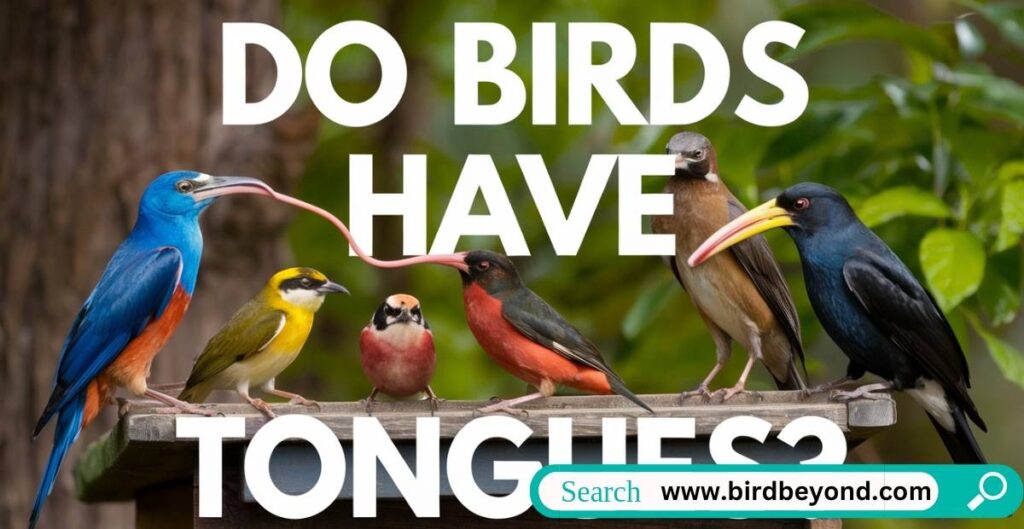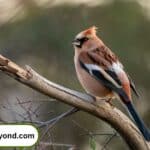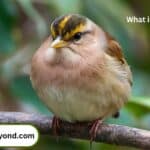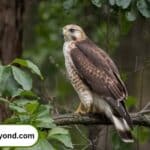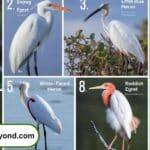Have you ever wondered, “Do birds have tongues?” It’s a question that might seem simple at first, but the answer reveals a fascinating world of adaptation and specialization in the avian kingdom. In this comprehensive exploration, we’ll uncover the surprising truth about bird tongues and their incredible diversity.
Introduction: The Hidden Marvels of Bird Tongues
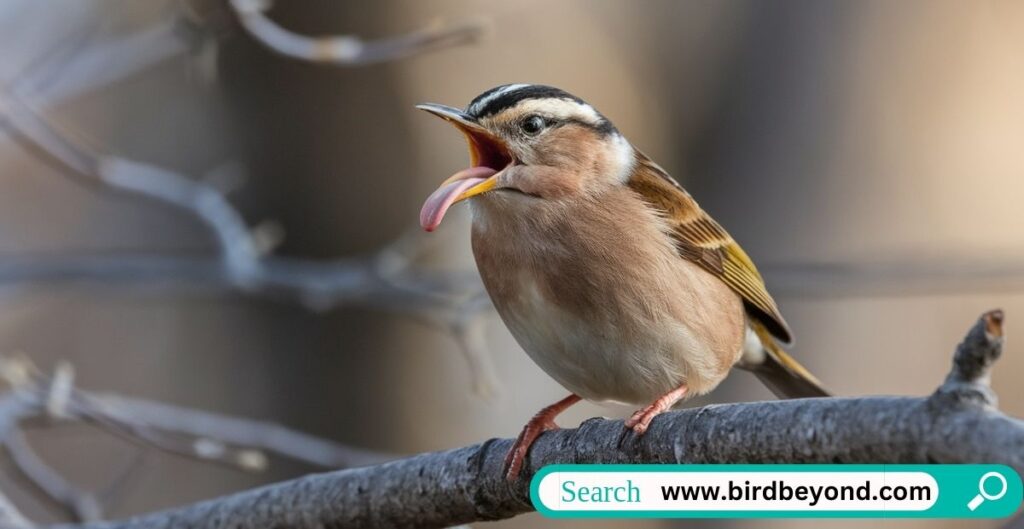
When we think of birds, we often picture their colorful feathers, melodious songs, or graceful flight. But beneath those beaks lies a crucial yet often overlooked anatomical feature: the tongue. Yes, birds do have tongues, and they’re far more interesting and varied than you might imagine.
Did you know that some birds have tongues longer than their beaks? Or that certain species use their tongues as tools for catching prey? These surprising facts only scratch the surface of the incredible adaptations birds have developed in their oral anatomy.
Bird tongues play a vital role in avian biology, influencing everything from feeding habits to vocalization. Understanding these structures helps us appreciate the intricate design of nature and the remarkable ways birds have evolved to thrive in diverse environments.
The Evolution of Bird Tongues: From Dinosaurs to Modern Avians
To truly understand bird tongues, we need to take a step back in time. The story of avian tongue evolution is a tale that spans millions of years, from the age of dinosaurs to the diverse array of bird species we see today.
Birds, as we now know, evolved from theropod dinosaurs. Recent paleontological discoveries have shed light on the tongue structures of these ancient ancestors. For instance, the fossil record shows that some dinosaurs had hyoid bones – the structures that support the tongue – similar to those found in modern birds.
“The evolution of bird tongues is a testament to nature’s ingenuity in adapting to new ecological niches.” – Dr. Avian Biologist
As birds evolved to occupy various ecological niches, their tongues underwent significant changes. This process of adaptive radiation led to the incredible diversity we see in bird tongue morphology today. For example:
- Nectar feeders developed long, brush-tipped tongues
- Insectivores evolved sticky or barbed tongues for catching prey
- Seed eaters developed muscular tongues for manipulating food
- Aquatic birds adapted filter-feeding mechanisms
This specialization allowed birds to occupy a wide range of habitats and ecological roles, contributing to their success as a group.
Bird Tongue Anatomy: More Than Meets the Eye
Now that we’ve established that birds do indeed have tongues, let’s take a closer look at their structure and how they compare to other animals.
General Structure and Components
A bird’s tongue typically consists of several key components:
- Epithelium: The outer layer of tissue
- Muscles: For movement and control
- Salivary glands: To produce saliva for lubrication
- Nerves: For sensory input and muscle control
- Hyoid apparatus: The supporting bone structure
These components work together to create a highly functional organ that’s crucial for a bird’s survival. The specific arrangement and development of these structures can vary greatly between species, reflecting their diverse feeding habits and ecological roles.
Variations Across Species: A Dive into Bird Tongue Types
While the basic structure remains consistent, the specific shape and features of bird tongues can vary dramatically between species. Here’s a table showcasing some of these variations:
| Species | Tongue Characteristic | Function |
|---|---|---|
| Hummingbird | Long, tubular with brush-like tip | Nectar extraction |
| Woodpecker | Extremely long with barbs | Insect capture in tree bark |
| Flamingo | Thick, fleshy with lamellae | Filter feeding |
| Penguin | Covered in backwards-facing spines | Gripping slippery prey |
| Pelican | Small, supporting large pouch | Fish capture and water drainage |
These diverse tongue structures highlight the remarkable adaptability of birds and how their oral anatomy has evolved to suit their specific dietary needs and habitats.
Comparison with Mammalian Tongues
While bird tongues share some similarities with mammalian tongues, there are key differences:
- Size: Bird tongues are generally smaller relative to body size
- Taste buds: Birds have fewer taste buds compared to mammals
- Mobility: Many bird tongues are more rigid and less mobile
- Specialization: Bird tongues often show more extreme adaptations for specific feeding habits
These differences highlight the unique evolutionary path birds have taken in developing their oral anatomy, adapting to their specific ecological niches and dietary requirements.
The Diversity of Bird Tongues: Nature’s Ingenious Designs
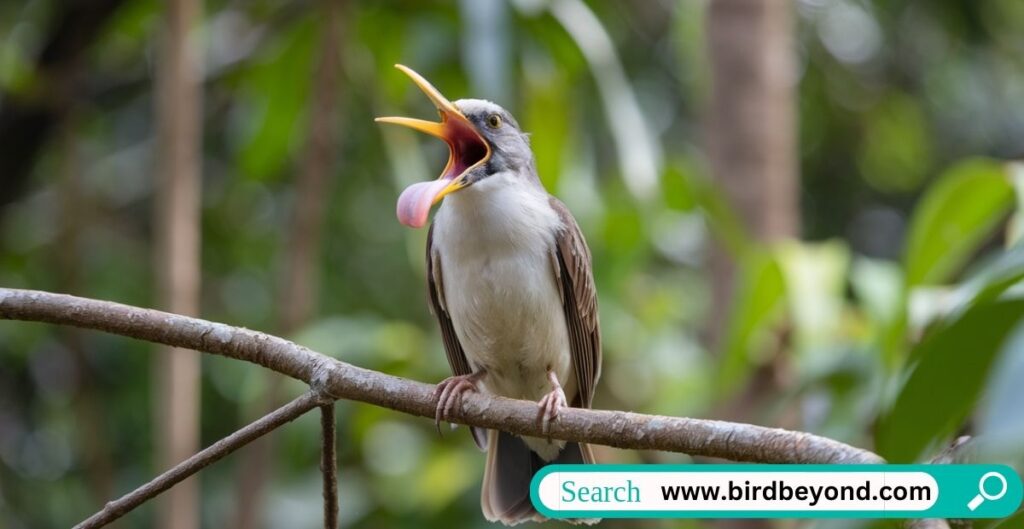
The variety of bird tongues is truly astounding. Let’s explore some of the most remarkable adaptations found across different species, showcasing how birds use their tongues for various functions.
Hummingbirds: Nature’s Nectar Specialists
Hummingbirds are renowned for their ability to hover and feed on nectar from flowers. Their tongues are perfectly adapted for this task:
- Extremely long, often twice the length of the beak
- Forked at the tip with hair-like structures called lamellae
- Can be extended and retracted up to 20 times per second
- Uses capillary action to draw up nectar
These features allow hummingbirds to access nectar from deep within flowers, making them essential pollinators in many ecosystems. The specialized tongue structure of hummingbirds is a prime example of how bird tongues have evolved for specific feeding functions.
Woodpeckers: Sticky Tongues for Insect Capture
Woodpeckers have one of the most extraordinary tongue adaptations in the bird world:
- Tongue can extend up to 4 inches beyond the tip of the beak
- Wraps around the skull when retracted
- Covered in sticky saliva and backward-facing barbs
- Used to extract insects from deep within tree bark
This remarkable adaptation allows woodpeckers to access food sources that are inaccessible to other birds. The woodpecker’s tongue is a testament to the incredible specialization of bird tongues for specific feeding strategies.
Flamingos: Filter-feeding with Lamellae
Flamingos have a unique feeding mechanism that relies heavily on their specialized tongues:
- Thick and fleshy with hair-like structures called lamellae
- Works in conjunction with the bill to filter tiny organisms from water
- Pumps water in and out of the bill up to four times per second
- Can filter particles as small as 10 micrometers
This adaptation allows flamingos to thrive in environments where other birds might struggle to find food. The flamingo’s tongue structure is a perfect example of how bird tongues have evolved to suit specific ecological niches.
Functions of Bird Tongues: Beyond Just Tasting
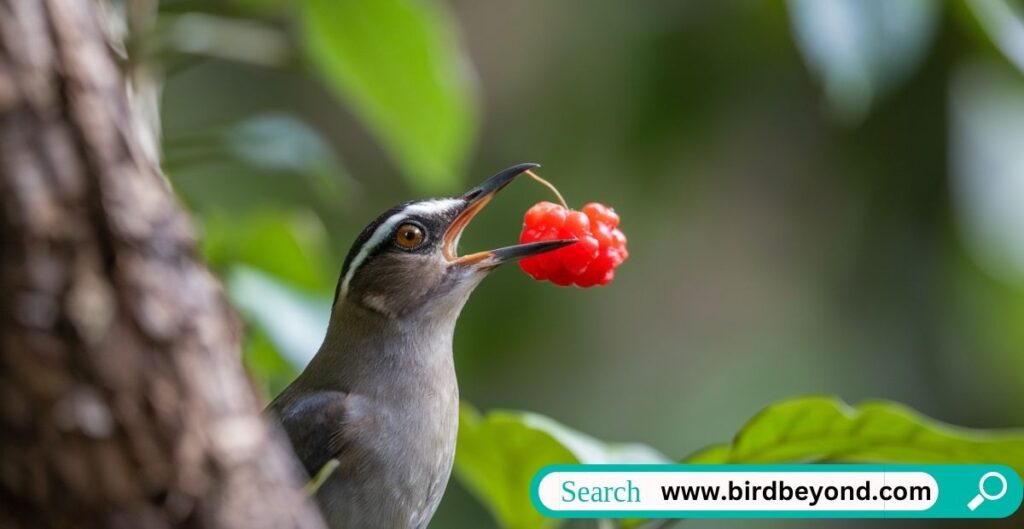
Bird tongues serve a variety of crucial functions beyond just tasting food. Let’s explore the multifaceted roles these organs play in avian life, demonstrating how birds use their tongues for various purposes.
Feeding Mechanisms: The Primary Function
The primary function of bird tongues is to assist in feeding. Different species have evolved various strategies:
- Nectar collection: Hummingbirds and sunbirds use their long, tubular tongues to extract nectar from flowers.
- Seed manipulation: Finches and parrots use muscular tongues to maneuver seeds within their beaks for cracking.
- Prey capture and swallowing: Insectivorous birds like swifts use their tongues to help catch and guide insects down their throats.
These diverse feeding mechanisms showcase the incredible adaptability of bird tongues and their crucial role in avian survival.
Vocalization and Sound Production: The Tongue’s Role in Bird Songs
While not the primary organ for vocalization (that would be the syrinx), the tongue plays a role in modifying sounds:
- Helps shape the oral cavity for different vocalizations
- Assists in producing certain clicks and whistles
- May contribute to the complexity of bird songs in some species
The involvement of bird tongues in vocalization demonstrates their importance beyond just feeding, contributing to the rich acoustic world of avian communication.
Thermoregulation: Keeping Cool with Tongues
Some birds use their tongues as part of their cooling mechanism:
- Panting with an open beak and extended tongue increases evaporative cooling
- This is particularly important for species living in hot environments
This heat regulation function of bird tongues showcases their versatility and importance in avian physiology.
Grooming and Preening: The Tongue as a Cleaning Tool
Birds also use their tongues in grooming:
- Helps distribute oils from the preen gland across feathers
- Assists in removing parasites or debris from feathers
This grooming function highlights yet another way in which birds use their tongues for essential daily tasks.
Sensory Capabilities of Bird Tongues: More Than Just Taste
While bird tongues may not be as sensitive as human tongues, they still play an important sensory role. Let’s explore the sensory functions of bird tongues and how they contribute to avian perception.
Taste Perception in Birds: A Different Palate
Contrary to popular belief, birds do have a sense of taste, although it’s generally less developed than in mammals:
- Most birds have between 50 and 500 taste buds (compared to humans’ 10,000)
- Can detect sweet, sour, and bitter tastes
- Some species, like parrots, have more developed taste perception
This taste function of bird tongues, while different from mammals, plays a crucial role in their food selection and dietary habits.
Mechanoreceptors and Touch Sensitivity: Feeling with the Tongue
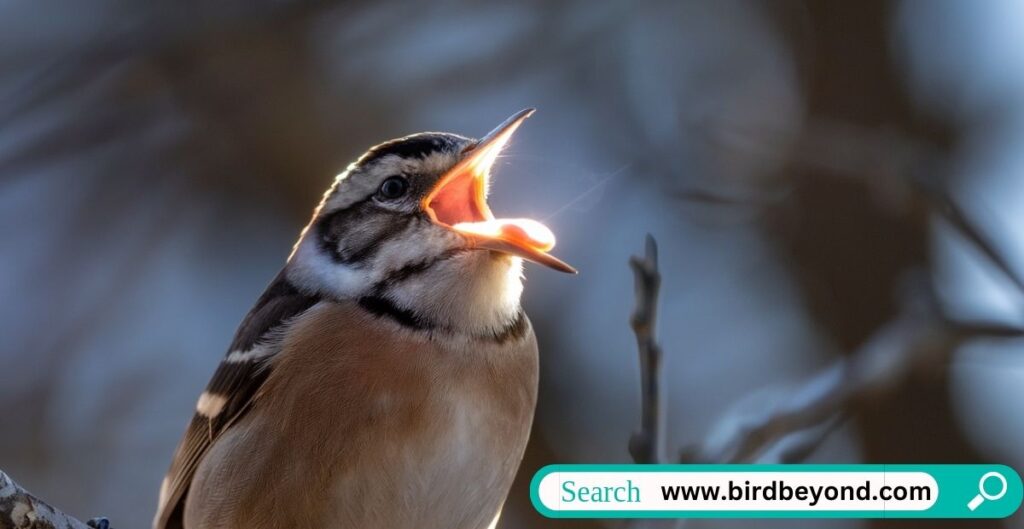
Bird tongues contain mechanoreceptors that provide tactile information:
- Helps in assessing food texture and consistency
- Assists in manipulating food items within the beak
This tactile function of bird tongues demonstrates their importance in food assessment and manipulation.
The Tongue’s Role in Food Assessment: A Multifaceted Tool
Beyond taste, the tongue helps birds evaluate their food in other ways:
- Detects temperature of food items
- Assesses hardness or softness of potential food
- Helps determine if an item is too large to swallow
These assessment capabilities highlight the sophisticated role that bird tongues play in feeding behavior.
Unique Adaptations and Specializations: Nature’s Marvels
Some bird species have developed truly extraordinary tongue adaptations. Let’s look at a few standout examples that showcase the incredible diversity of bird tongue structures:
The Black Woodpecker’s 4-inch Tongue: A Record-Breaking Organ
The Black Woodpecker (Dryocopus martius) boasts one of the longest tongues relative to body size in the bird world:
- Can extend up to 4 inches beyond the tip of the beak
- Wraps around the bird’s brain when retracted
- Covered in sticky saliva for catching insects
This remarkable adaptation allows the woodpecker to extract insects from deep within tree trunks and branches, demonstrating the extreme specialization of bird tongues for specific feeding strategies.
Crossbills: Tongues that Complement Crossed Beaks
Crossbills (genus Loxia) have uniquely shaped beaks and tongues designed for extracting seeds from conifer cones:
- Tongue is grooved to fit perfectly with the crossed mandibles
- Works like a piston to extract seeds from between cone scales
- Allows the bird to access a food source that few other species can exploit
This specialized tongue structure showcases how bird tongues can evolve in tandem with beak shape to create highly efficient feeding mechanisms.
Lorikeets: Brush-tipped Tongues for Pollen and Nectar
Lorikeets have developed a specialized tongue for their diet of nectar and pollen:
- Tip of the tongue has fine bristles, forming a brush-like structure
- Ideal for collecting pollen and lapping up nectar
- Also helps in extracting fruit pulp
This adaptation allows lorikeets to occupy a unique dietary niche among parrots, highlighting the diversity of bird tongue structures even within closely related species.
Conclusion: The Unsung Heroes of Avian Anatomy
As we’ve discovered, the answer to “Do birds have tongues?” is a resounding yes – and these tongues are far more fascinating and diverse than many people realize. From the nectar-sipping apparatus of hummingbirds to the sticky, extendable tools of woodpeckers, bird tongues showcase nature’s incredible capacity for adaptation and specialization.
These often-overlooked organs play crucial roles in feeding, sensory perception, and even thermoregulation. They’ve evolved alongside beaks and digestive systems to allow birds to exploit a wide range of ecological niches, contributing to the remarkable success and diversity of birds as a group.
As we continue to study and understand bird tongues, we’re likely to uncover even more surprises. Future research might reveal new insights into bird behavior, ecology, and evolution. Moreover, the unique adaptations we observe in bird tongues may continue to inspire innovations in fields ranging from medicine to engineering.
The next time you spot a bird in your backyard or on a nature walk, take a moment to appreciate the hidden marvel inside its beak. The humble bird tongue, in all its varied forms, truly is an unsung hero of avian anatomy – a testament to the wonders of evolution and the intricate beauty of the natural world.
By understanding the incredible diversity and functionality of bird tongues, we gain a deeper appreciation for the complexity of avian life and the marvels of evolutionary adaptation. So, the next time someone asks you, “Do birds have tongues?” you can not only answer with a confident “Yes!” but also share some of the fascinating facts about these remarkable organs.
FAQs
Do birds have tongues?
Yes, all birds have tongues. These organs are crucial for feeding, vocalization, and grooming. Different bird species have unique tongue structures adapted to their diet and lifestyle. For example, woodpeckers have long, barbed tongues to extract insects, while hummingbirds have tubular tongues designed for sipping nectar.
How do bird tongues differ from species to species?
Bird tongues are highly specialized depending on the species and its feeding habits. Hummingbirds have long, tubular tongues that split at the tip to collect nectar. Woodpeckers have barbed tongues to catch insects, while parrots have muscular, flexible tongues that help them manipulate food.
What role do bird tongues play in feeding?
Bird tongues help birds manipulate and consume their food. Seed-eating birds use their tongues to crack seeds, nectar feeders sip with their tongues, and carnivorous birds use theirs to tear flesh from prey. The shape and structure of the tongue reflect the bird’s diet.
Do bird tongues help with vocalization?
Yes, birds use their tongues to manipulate airflow and produce various sounds, including complex songs and vocalizations. Species like parrots even use their tongues to mimic human speech.
What other functions do bird tongues have?
In addition to feeding and vocalization, bird tongues assist in grooming. Some birds use their tongues to spread oil from their preen glands onto their feathers for waterproofing. They may also play a role in thermoregulation, as certain birds, like nighthawks, cool off by fluttering their tongues.

William Henry is a distinguished blogger with a flair for avian storytelling. With a wealth of experience, he delivers captivating insights and expert knowledge to Bird Beyond. William’s passion for birds and his engaging writing style make him a standout voice in the birdwatching community, offering readers both valuable information and delightful narratives.

